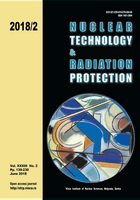
ALARM SYSTEM FOR SURVEILLANCE OF PATIENTS RECEIVING HIGH DOSES OF RADIOIODINE (131I) THERAPY IN THE CASE OF UNAUTHORISED ABANDONING OF A CONTROLLED AREA

Vol.
XXXIII, No. 2, Pp. 139-230
June 2018
UDC 621.039+614.876:504.06
ISSN 1451-3994
Pages: 223-229
Authors: Milovan D. Matović, Miroslav D. Ravlić, Marija Ž. Jeremić, Slobodan M. Janković,
and Marina Ž. VlajkovićAbstract
After receiving high doses of radioiodine the patients have to remain isolated within the “restricted area”, until the radioactivity of the body drops below a certain level. The aim of this paper was to present our alarming system designed to discover patients who attempt to abandon the “restricted area” and inform medical staff about the event. The system consists of a survey-meter with a pancake probe directed towards the corridor. The survey-meter is connected to a trigger circuit which gives a signal in the case when the measured count rate exceeds a pre-set value. This signal sets “on” the alarm device, blinking light, programmable siren and IP camera, in order to warn the patient and inform the personnel when such a case occurs. In order to test the consistency and sensitivity of our system we measured ten times the ambient dose equivalent, H*(10), from the source of 925 MBq (25 mCi) 131I, kept at a distance of 1 m. The average ambient dose equivalent was 77.73 ± 31.57 (0.084 µSvh-1 per MBq, or 3.1 µSvh-1 per mCi). We measured ten times the same source at various distances (1-2.25 m) from the probe. In each position, the system was triggered. Also we tested the system on 40 patients treated with radioiodine instructed to pass through the corridor. Each of their attempts triggered the system. According to our experience gained over the past few years, this alarm system intended for patients receiving radionuclide therapy ensures a high level of safety for both the patients and medical staff.
Key words: radioiodine, alarm system, patient behavior
FULL PAPER IN PDF FORMAT (720 KB)